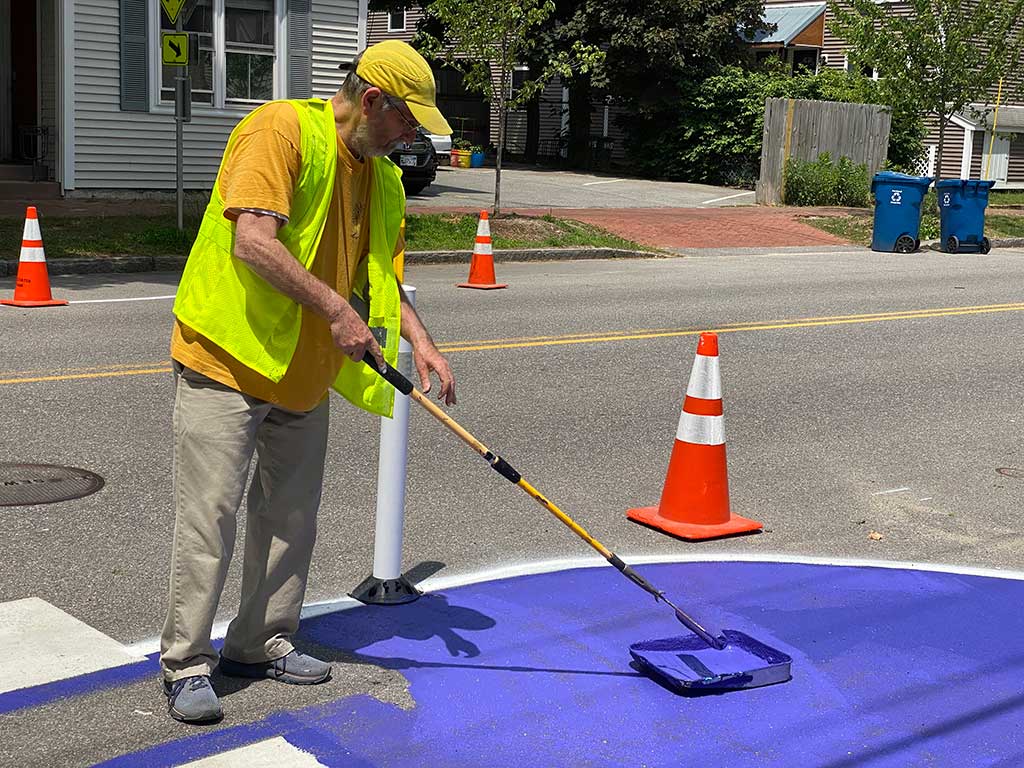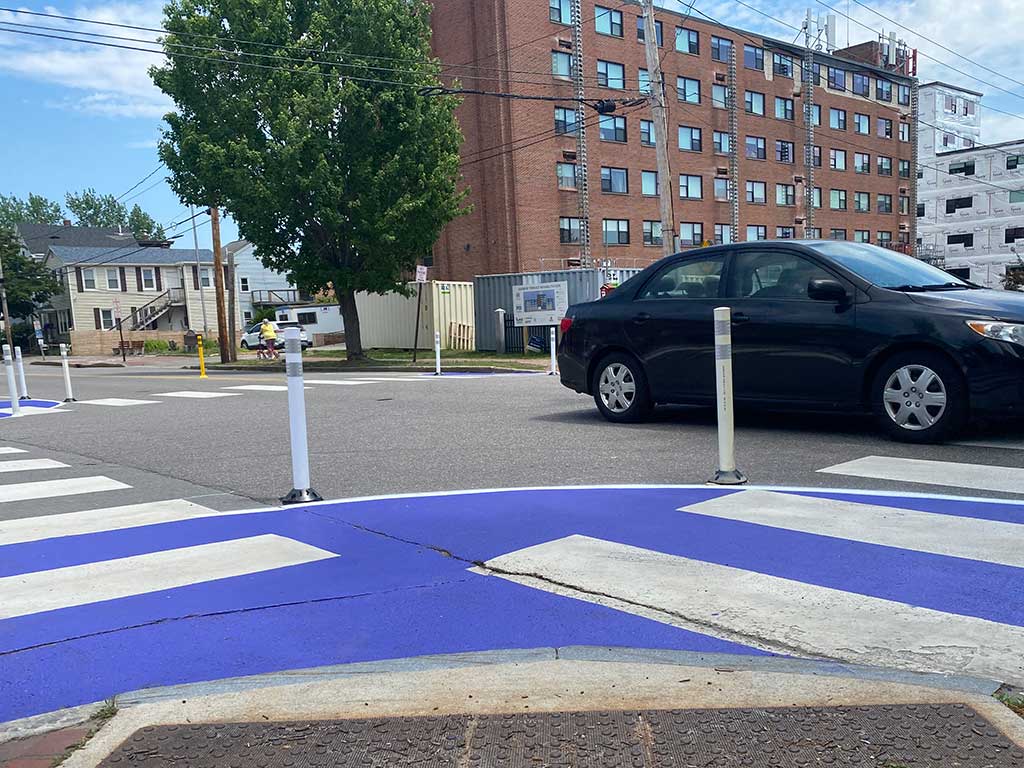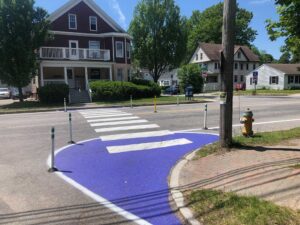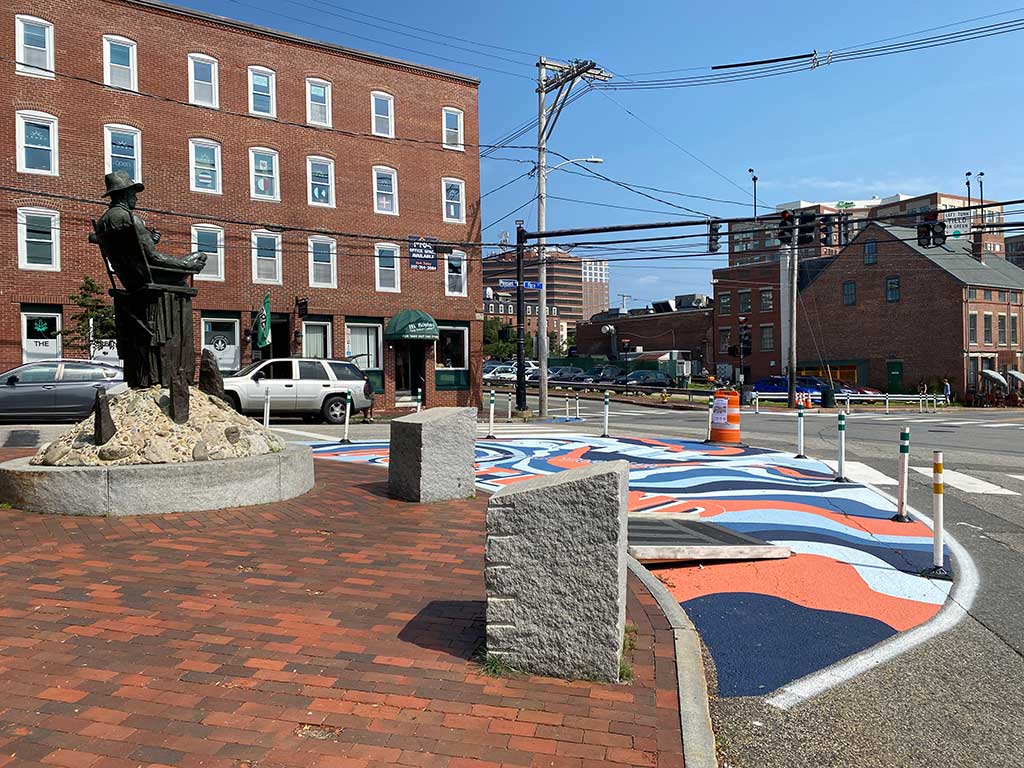Neighborhood groups, Portland Trails install traffic calming projects in Libbytown, West End
By Tony Zeli
This summer, if you drive down Portland’s Brighton Avenue or Danforth Street, you’ll see the purple paint the volunteers have rolled out. Portland Trails is partnering with Libbytown Neighborhood Association, West End Neighborhood Association (WENA), Bicycle Coalition of Maine, and the City of Portland to install traffic calming projects on Brighton (at the intersections with Whitney Avenue and Bolton Street) and Danforth (at May Street and Emery Street).

The Libbytown and West End neighborhood associations have observed drivers ignoring pedestrians who want to cross. Extending the curbs and highlighting the crosswalk, these purple bump outs along with temporary vertical elements should make pedestrians more visible and slow down traffic.
Volunteers Lead
WENA member Gregory Farino, who took the lead organizing volunteers with WENA, lives on Danforth Street near the elderly community at Harbor Terrace. We spoke as he painted on a hot June afternoon. He told me that even those who are mobility challenged, sometimes with walkers or electric chairs, couldn’t catch a break from drivers.
“It’s a perennial issue. I mean, even since we’ve been here (volunteering), it seems like the traffic is increasing and speed is not decreasing,” said Farino.

Gordon Platt a member of the Portland Bicycle and Pedestrian Advisory Committee (PBPAC), a group promoting bicycle and pedestrian issues, was volunteering that day, too. He backed up all that Farino said. Platt is a resident of the West End’s Taylor Street. He told me, “I walk through here, I drive through here, I bike through here… A lot of people use it as a cut through street and they go too fast. I’m excited to see this squeeze the street a little bit… and show people that people live here. These streets are for people, and drivers can afford to slow down a little bit.”
Yielding to Pedestrians

Portland Trails’ has studied the intersections, and they say their data back up this anecdotal evidence. Many drivers are not yielding to pedestrians. “On Brighton Avenue, one pedestrian waited for twenty-four vehicles to pass before one stopped,” said Jaime Parker of Portland Trails.
According to Parker, an early look at the data shows that the traffic calming efforts work to reduce speed. In fact, on Brighton Avenue the efforts have already increased crosswalk yield rates. After all, it is easier to stop for a pedestrian if you are going slower, Parked noted.
“These are demonstration projects,” Parker continued, “So, they are meant to be temporary and meant to show basically how easy it is to achieve better outcomes for neighborhoods like slowing traffic down to a safe level.”
Gorham’s Corner Traffic Calming Demonstration
In fact, a similar – though splashier version – at Gorham’s Corner downtown was popular with pedestrians – and for selfies. Last summer, this five-way intersection where the West End, downtown, and the Old Port come together (also, home to the John Ford statue), got a facelift.

Local artist Jill Perry created a large mural that reads, “Smile, you’re in Portland,” along with other nautical themed murals. These elements along with two new crosswalks and temporary vertical bollards (removed for the winter and not reinstalled) did slow traffic.
“That was an exciting project for us, and it was really successful with the murals and the change in traffic patterns,” said Parker, “people really felt a lot safer there.”
Proof of Concept
The groups collected speed and yield studies prior to installing the traffic calming measures. They say they will continue to collect data through the fall.
“The idea was to prove the concept and work with the City to come up with long term solutions,” said Parker. He was encouraged by the early data that demonstrated how these low-cost implementations can make a big difference.
It helps that volunteers are taking the lead. When I visited the group of WENA volunteers, it was around noontime on a hot early June day. But Farino and Platt were happy to be painting the streets. Neighbors were already thanking them. One asked if they could do the rest of the crosswalks.
To that end, Parker said he wants to hear from other neighborhood groups about other intersections in need of traffic calming projects. Portland Trails wants to support grassroots efforts where they can, he said.
To learn more or to give feedback about this project, please visit https://www.trails.org/our-work/active-transportation/2024-traffic-calming-demonstrations/.





